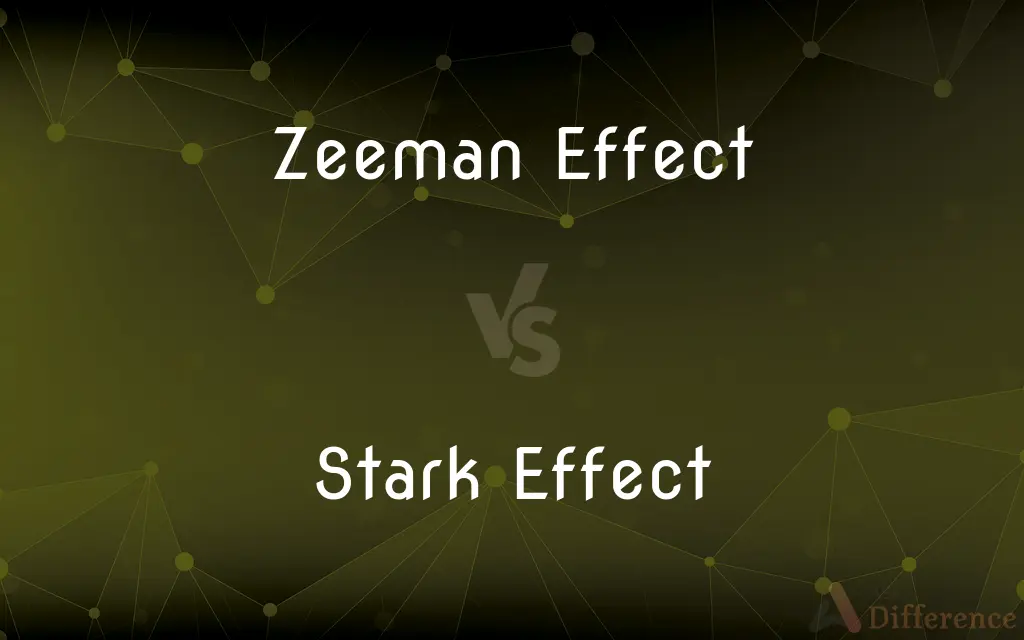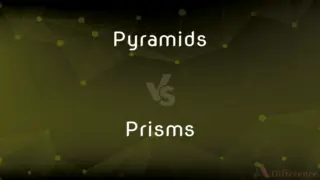Zeeman Effect vs. Stark Effect — What's the Difference?
By Tayyaba Rehman — Published on November 25, 2023
Zeeman Effect is the splitting of spectral lines in a magnetic field; Stark Effect is the splitting due to an electric field.

Difference Between Zeeman Effect and Stark Effect
Table of Contents
ADVERTISEMENT
Key Differences
Zeeman Effect refers to the phenomenon where spectral lines split or broaden due to the presence of a magnetic field. This effect was discovered by Pieter Zeeman in 1896 and helps in understanding the interaction between magnetic fields and atomic structures.
Stark Effect, conversely, is analogous to the Zeeman Effect but is observed when an external electric field is applied. Discovered by Johannes Stark in 1913, this effect showcases how electric fields can influence atomic and molecular spectra. Both effects provide insights into atomic and molecular structures and their interactions with external fields.
While the Zeeman Effect specifically deals with the impact of magnetic fields, the Stark Effect is all about electric fields. The underlying reason for these phenomena lies in how these fields interact with the intrinsic angular momentum of electrons in atoms and molecules.
Both the Zeeman Effect and Stark Effect have found applications in various scientific and technological areas. From understanding atomic structures to facilitating certain types of spectroscopy, these effects are crucial in the realm of atomic physics. The beauty of these phenomena lies in their ability to unveil intricate details of atomic and molecular behaviors under the influence of external fields.
Comparison Chart
Field involved
Magnetic
Electric
ADVERTISEMENT
Discovered by
Pieter Zeeman
Johannes Stark
Nature of Splitting
Due to magnetic field interaction
Due to electric field interaction
Underlying principle
Interaction with magnetic moments
Interaction with electric dipole moments
Applications
Magnetic field measurements, spectroscopy
Electric field measurements, precision spectroscopy
Compare with Definitions
Zeeman Effect
Discovered in 1896 by Pieter Zeeman.
The discovery of the Zeeman Effect was groundbreaking in atomic physics.
Stark Effect
Stark Effect involves spectral line splitting by an electric field.
The Stark Effect was clearly visible when the molecule was subjected to a high electric field.
Zeeman Effect
It reveals atomic interactions with magnetic fields.
Scientists study the Zeeman Effect to understand atomic magnetic moments.
Stark Effect
Applied in precision spectroscopy techniques.
Stark Effect is used to fine-tune measurements in precision spectroscopy.
Zeeman Effect
It can be normal or anomalous depending on electron transitions.
The anomalous Zeeman Effect is more complex due to spin angular momentum.
Stark Effect
It showcases interactions of atoms with electric fields.
Through the Stark Effect, scientists can measure electric dipole moments.
Zeeman Effect
Used in various areas of spectroscopy.
The Zeeman Effect is crucial in certain magnetic resonance techniques.
Stark Effect
It can be linear or quadratic based on field strengths.
The linear Stark Effect is observed in certain atoms with appropriate energy levels.
Zeeman Effect
Zeeman Effect is spectral line splitting due to a magnetic field.
The Zeeman Effect was observed when the atom was placed in a strong magnetic field.
Stark Effect
Identified in 1913 by Johannes Stark.
Johannes Stark's work on the Stark Effect earned him a Nobel Prize.
Common Curiosities
And the Stark Effect?
Stark Effect describes the splitting of spectral lines due to an external electric field.
Can both effects be observed simultaneously?
Yes, both effects can coexist, but isolating each effect requires controlled conditions.
Who identified the Stark Effect?
The Stark Effect was identified by Johannes Stark.
Who discovered the Zeeman Effect?
The Zeeman Effect was discovered by Pieter Zeeman.
Why do these effects occur?
They result from interactions of external fields with atomic or molecular structures.
What about Stark Effect applications?
Stark Effect finds use in electric field measurements and precision spectroscopy.
What's the primary difference between Zeeman and Stark Effects?
Zeeman Effect involves magnetic fields, while Stark Effect involves electric fields.
What does the Zeeman Effect describe?
The Zeeman Effect describes the splitting of spectral lines in the presence of a magnetic field.
Are there applications of the Zeeman Effect in technology?
Yes, the Zeeman Effect has applications in magnetic field measurements and magnetic resonance.
Is the splitting always uniform in the Zeeman Effect?
No, the splitting can vary, leading to normal or anomalous Zeeman Effects.
What role did these effects play in science?
Both effects deepened our understanding of atomic and molecular interactions with external fields.
Can the Stark Effect be seen in all atoms?
No, only in atoms or molecules with appropriate energy levels and structures.
Are the Zeeman and Stark Effects related to quantum mechanics?
Yes, both effects can be explained using quantum mechanics and have deepened our understanding of it.
How about the Stark Effect, is the splitting uniform?
Stark Effect can be linear or quadratic, depending on field strengths and atomic structures.
Share Your Discovery

Previous Comparison
Sea Salt vs. Rock Salt
Next Comparison
Pyramids vs. PrismsAuthor Spotlight
Written by
Tayyaba RehmanTayyaba Rehman is a distinguished writer, currently serving as a primary contributor to askdifference.com. As a researcher in semantics and etymology, Tayyaba's passion for the complexity of languages and their distinctions has found a perfect home on the platform. Tayyaba delves into the intricacies of language, distinguishing between commonly confused words and phrases, thereby providing clarity for readers worldwide.












































